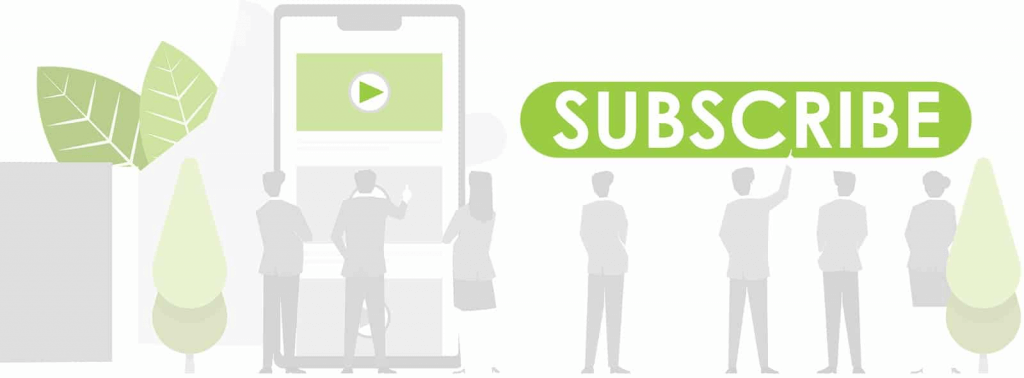If you want to create engaging YouTube ads that people actually watch, then you need to have a structured and compelling video script.
Most people don’t have a lot of patience when it comes to watching ads even if they only last for a couple of minutes.
So, how can you capture and hold their attention all throughout your video?
What things do you need to say to clearly communicate to the right audience what your offer is?
That’s exactly what we’re talking about today.
By the end of this post, you should be able to write and structure your own video scripts without a sweat. Plus, we’re giving you FREE templates you can use to start right away!
Get our FREE YouTube Scripts Template!
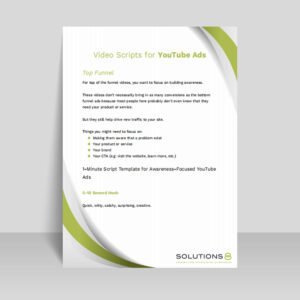
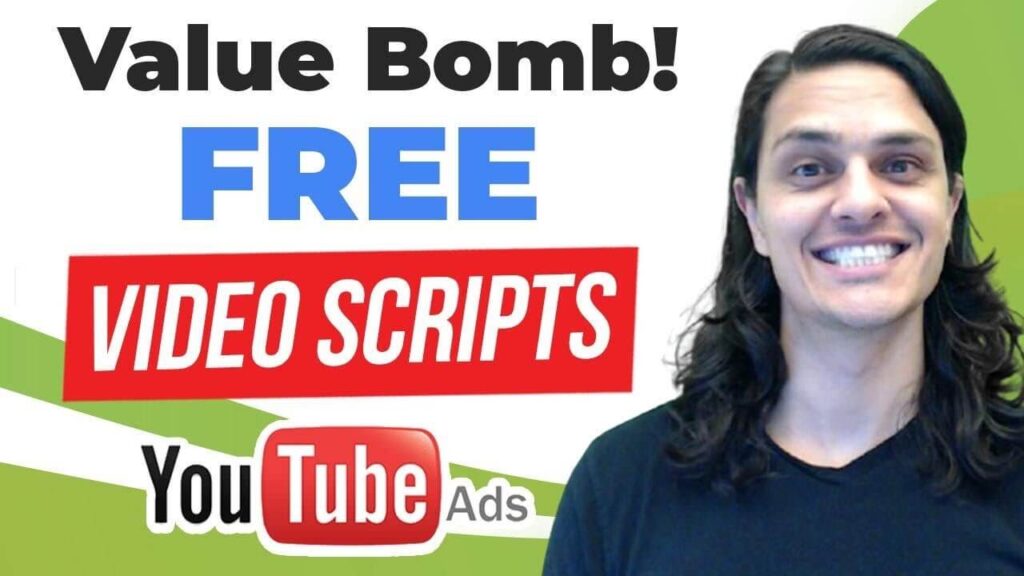
Connect With Their Identity
First off, your videos should be speaking to the right audience. To successfully do that, you’ll have to point out to them their identity. In other words, who your product is for.
If you’ve done your research and created your ideal customer, then you already have the identity down. You just need to address your viewers so they know you’re talking about them.
Here are two of the most common ways to do that:
1. Address your specific audience by mentioning their demographics–age, gender, job, location, marital status.
Do they speak a certain way that only people of the same demographic group can relate to?
Here’s an example from Chatbooks’ ad:
“I have three kids and I work from home so people call and ask me how I stay organized…”
2. Address your specific audience by mentioning their psychographics. Maybe your prospects have certain beliefs, values, and behaviors that separate them from others.
Here’s the continuation of the Chatbooks’ ad script:
“I’m kidding. Do you think I have time for a bath?”
Any mother who has kids can easily relate to the previous example. But “no time for a bath” is a different story that targets a more specific audience.
It’s a story that only those people who have experienced it know. It speaks directly to mothers who don’t have time to do things they want.
Even though mentioning demographics of your prospect is effective, it doesn’t go as deep and powerful as their psychographics.
That’s because demographics points to groups of people who share similar statistical data.
Psychographics point to individuals’ experience. And one of those is their “problem.”

Source: Chatbooks’ YouTube video
Describe Their Problem
You’ve probably heard this before: “Most people are wired to be more motivated to move away from pain than they are towards pleasure.”
If your prospects aren’t aware of their problem, it’s going to be impossible to make them buy. That’s why it’s important to describe your prospect’s problem in a way that they perceive it.
One of the most common mistakes that people make is talking about a problem that isn’t tangible and visible. Here’s an example of a vague problem description:
“Do you feel stressed and overwhelmed?”
Leading your video this way only guarantees more confusion. Aside from that, it only talks about their feelings – not the actions that caused them to feel a certain way.
Don’t keep them guessing. You want to instantly capture their attention by talking about their problem the way they describe them. What do they see/hear/do when they’re having this problem?
“It’s hard to manage my workload. My team keeps missing deadlines.”
When you describe the problem this way, you automatically build rapport, connection, and show that you understand exactly what they’re going through. Then, lead them towards the intangible stuff – what they feel.
“Struggling to meet deadlines? Feeling stressed and overwhelmed by a mountain of work?”
Another thing you might want to do is point out the consequences of not solving the problem. What happens if they keep missing deadlines?
“Constantly missing deadlines can lead to losing projects––or worse, getting fired.”
Agitating the problem by showing what the possible consequences will get them to do one thing: Find a solution.
Offer Solutions
Pointing out the solution is even more important than mainly stating the problem.
Unfortunately, a lot of people focus too much on selling their product instead of selling the solution. They talk about what the product is (features) but not what the product does (benefits.)
But here’s the thing. People buy the transformation, not the product.
They want to know how your product can help them gain something they don’t currently have.
They want the results.
How will your product transform people’s lives? That’s what you need to communicate. Do that by talking about the benefits of your product.
Want to showcase the features of your products? No problem! Just make sure they’re tied to the benefits of the product.
For example:
“Our software has a project dashboard [feature] that helps you easily view, access, and monitor all projects, making task management more convenient and efficient [benefit].”
Eliminate Objections
It’s not uncommon for people to have certain objections about your product. If they didn’t have any, they’re either not interested or they’ve already bought your or your competitor’s product.
Having objections is not a bad thing. In fact, anyone who has an objection about your product is probably a hot lead! You just need to know how to flip it.
Objections usually fall into two categories – general and offer-specific.
1. General objections are those that involve time, money, and beliefs (e.g., “I don’t have time to do this,” “I don’t have the funds right now,” “I don’t think this will work.”)
The way to handle these objections is by understanding the meta frame – what they’re really saying.
“I don’t have time to go to the gym.” What they’re really saying is going to the gym is not important enough to make a priority.
“I don’t have money.” What they’re really saying is they don’t see the value of the product relative to its cost.
“I don’t think this will work.” What they’re really saying is they don’t trust the product/service because they haven’t seen it work yet.
2. Offer-specific objections are those that revolve around your product and the way it’s offered.
For example, the company Stairslide sells a product that turns your stairs into a slide. In their ad, one of the questions the mother asked is “but is it safe?”
And her son addressed it by saying:
“I’m no lawyer. So, legally I can’t say it’s ‘more safe’ than any other way to slide down stairs. But it’s definitely safer than other ways I’ve ‘slided’ down stairs.”
So, list down the possible objections your prospects might have about your product. Then, find out how you can dismantle those objections. You can also use these language patterns to shift your prospects’ perceptions and beliefs.
That said, if you really want to turn a skeptical audience into hot leads, then look no further because I’m about to tell you the most effective way to address objections.
And that is to show proof!
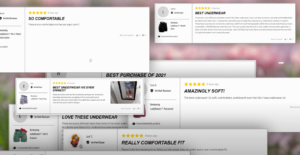
Show Proof
Anyone can make bold claims about their products – and most business owners do. However, making big promises, more often than not, tends to backfire.
Instead of attracting customers, it repels them.
Why? Because they’ve “heard it all before.”
I wish it were that easy to convince people. But with all the ads people are exposed to every day, the market is becoming more and more sophisticated.
That’s why it’s important to show proof.
Weight loss industries leverage proof in their ads. It’s almost impossible to see a weight loss or fitness product that doesn’t somehow show photos of their customers’ “before and after” journey. It’s a marketing technique that never fails.
If showing proof worked for them, it’ll work for you, too.
Here are a few ways to show proof in your video:
1. Read testimonials and reviews from your past customers. Here’s what Culprit Underwear did in their ad.
2. Talk about your best case study.
3. Highlight any social proof you have. Have you worked with a famous person or company? Do you have a significant amount of followers or subscribers? Have you received any note-worthy awards? Mention them.
The point is, including proofs in your video can make your promises legit and get you more sales.
Now that you know what it takes to create a great YouTube video script, it’s time to create a structure. And it all boils down to these three things:
1. What do you have?
2. What can it do for me?
3. How can I get it?
In other words, you need to create the hook, the content, and the call-to-action (CTA).
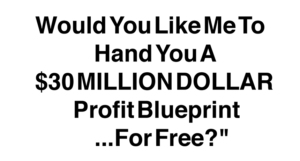
Source: Swiped.co
The Hook
The hook is probably the most important among all three. You can remove the CTA or the content, and still get people to watch. But removing the hook will have a big negative impact on your views. And here’s why.
It determines whether or not your viewers will watch your video. See, nobody likes being interrupted with video ads. People usually go on YouTube for two reasons: To learn or to be entertained.
Showing an ad while they’re watching is a form of interruption. Which means the ad better be darn good or else they’ll skip it.
Now, of course every click (and skip) matters. And you want to pay for clicks from interested people only. Which brings me to another advantage of using a hook…
It can act as a qualifier. This is especially true for skippable in-stream ads. By using a hook, you’ll effectively attract your target audience and repel those who aren’t interested.
Mention their identity together with their problem. For example, “If you’re a small business owner [identity] struggling to grow your Shopify store [problem], I can help.”
I know. It’s not the best hook in the world but it does what it needs to do.
Want to find out different ways to hook your audience, capture their interest, and keep them engaged? Check out our 5 Video Ad Sequences blog.
The Content
Since you already captured your viewers’ interest, you need to make sure they really grasp the advantage of your offer.
It’s hard to convince someone to buy if they barely know your product and what it can do for them.
That’s why you want to use the things we talked about earlier – the problem, solution, objection, and proof – in your message.
Now, depending on how long your video is, you may not need to include everything. And that’s okay. But at the very least, you must provide the outcome/benefit of your product and show proof that it works.
The CTA
Speaking of “taking action,” don’t forget to add a call-to-action (CTA) at the end of your videos.
Convince your viewers that now is the best time to take action. Make that thing easy to do.
If you want them to check out your website, mention the web address and add a link.
If it’s possible, give clear and detailed instructions. Tell them what’s going to happen next.
For example, instead of just saying “Download my ebook now!” say something like:
“Click the link below to download your ebook. Enter your email address, hit submit, then you’ll get the ebook delivered straight to your inbox in just a few minutes.”
And lastly, add a reason why they must act now. There’s no better way to motivate someone to do something than to tell them what’s in it for them.
For example, instead of saying “Shop now!” say something like:
“Shop now to get your 20% off.”
Adding an advantage to your CTA increases the desire to take action.
Don’t know what CTA to use? We got you covered. Here’s a list of the most commonly used CTAs:
You / Your (non-CTA)
Free (non-CTA)
Now
Get
Online
Apply
Save
Best
Act
Compare
Discover / Learn
Download
Call / Contact
View / See
Watch / Read
Try
Visit
Sign-up
Submit
Check
Look
Join
Purchase / Buy
Save
Request
Register
Order
Pay
Shop

The Only Things You Need to Create Your Video
We’ve shared some ads in the previous videos and you’re probably wondering “These ads look expensive to make! How much does it cost to create a video for my YouTube ads?”
The good news is you don’t have to spend thousands of dollars for a project like this. And we’d rather you use that money for your ad spend.
You don’t need expensive gears, backgrounds, and you don’t even need to travel. You can shoot the video at home if you like!
If you’re on a budget, here are a few things that you just need to get started:
1. Any decent camera that can take videos. This can be your phone, laptop, or DSLR. Just make sure that the videos you produce are of good quality. There’s nothing worse than a video that’s blurred or pixelated.
2. A teleprompter. If you’re anything like me, you probably don’t like memorizing. Well, a teleprompter is exactly what you need. It displays your text in front of you, making it easy to read your script. Here’s a video on how to use teleprompters.
If you’re using a phone, the most affordable teleprompter app I’ve used before is called Selvie App. If you’re reading it on your computer screen, try White Hat Crew’s free online teleprompter.
3. A video-editing software. First off, you can definitely use a video that’s not edited. One example is Tai Lopez’s very controversial ad. However, there are cases where you might want to cut or trim parts of your video. That’s where video-editing software helps.
There’s a lot of good video editing software out there. If you’re on a budget, YouCut is a popular choice for PC and android users while iMovie is good enough for Mac and iPhone users.
Bottomline
Investing in YouTube ads is one of the most effective ways to drive traffic and sales. After all, there’s a reason why it’s the world’s second-largest search engine.
The success of your ad depends on how well-targeted your audience is, and of course, how great your messaging is.
That’s why we created this post––to help you craft the right message in your scripts. Don’t forget to download these FREE YouTube Video Scripts so you don’t have to create everything from scratch!
Want to get know more about running YouTube Ads? Check out our YouTube channel! Just click the link below to subscribe.
Author
Bryan is the marketing manager at Solutions 8, and has been on digital marketing since 2018. When he’s not working, you’ll find him working out at a local gym, reading personal development books, or playing music at home. He feels weird writing about himself in third person.
 Bryan Caranto
Bryan Caranto